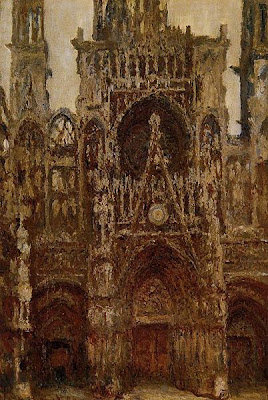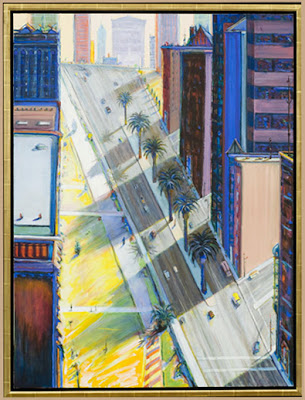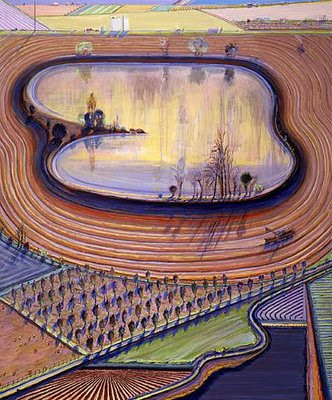As I was producing my series of oil paintings on Kerala, India, I posted some of the larger ones, which I tend to tackle first. Having dealt with the 2 metre and 1 metre jobs I finished with a series of small (for me) paintings (40 x 40 cm). These are almost more of a challenge than the larger canvases because there's nowhere to hide - they are snapshots of my interpretation of the South Indian landscape.
Pleased to say the exhibition which ran from mid-July to mid-September at Francis Kyle Gallery in Mayfair, was a success given the economic climate - all of the larger canvases sold.
Here are the titchy ones:
Selasa, 30 November 2010
Minggu, 28 November 2010
Claude Monet (Rouen Cathedral)
Author Hermione Cameron is, as I am writing this, walking in bitterly cold weather from London to Monte Carlo to raise funds for the RNLI (Royal National Lifeboat Institution) in memory of her husband Steve who died recently. A couple of days ago Hermione had reached the city of Rouen in Normandy where she visited the Cathedral.
In the 1890's Monet created a series of thirty paintings of Rouen Cathedral. The series captures the façade of the cathedral at different times of the day and year, and reflects changes in its appearance under different lighting conditions.
Historically, the series was well timed. In the early 1890s, France was seeing a religious revival and the subject was well received. Apart from its religious significance, Rouen Cathedral, built in the Gothic style, represented all that was best in French history and culture, being a style of architecture that was admired and adopted by the rest of Europe during the Middle Ages.
When Monet painted the Rouen Cathedral series, he had long since been impressed with the way light imparts to a subject a distinctly different character at different times of the day and the year, and as atmospheric conditions change. For Monet, the effects of light on a subject became as important as the subject itself. A selection of the Rouen series is shown below.
If you're able to make a donation, however small, to Hermione's fund for the RNLI please go to this link: www.justgiving.com/Hermione-Cameron
In the 1890's Monet created a series of thirty paintings of Rouen Cathedral. The series captures the façade of the cathedral at different times of the day and year, and reflects changes in its appearance under different lighting conditions.
Historically, the series was well timed. In the early 1890s, France was seeing a religious revival and the subject was well received. Apart from its religious significance, Rouen Cathedral, built in the Gothic style, represented all that was best in French history and culture, being a style of architecture that was admired and adopted by the rest of Europe during the Middle Ages.
When Monet painted the Rouen Cathedral series, he had long since been impressed with the way light imparts to a subject a distinctly different character at different times of the day and the year, and as atmospheric conditions change. For Monet, the effects of light on a subject became as important as the subject itself. A selection of the Rouen series is shown below.
If you're able to make a donation, however small, to Hermione's fund for the RNLI please go to this link: www.justgiving.com/Hermione-Cameron
Jumat, 26 November 2010
Wayne Thiebaud (cityscapes)
In the last of three postings on the paintings of Wayne Thiebaud (cakes, landscapes, & cityscapes) I'm taking a look at some of his cityscapes. Based on San Francisco with its dramatic hills where the roads rise and fall quite precipitously in places, they're a fanciful and exaggerated version of the reality.
For biographical information on Thiebaud see my two previous posts.
For biographical information on Thiebaud see my two previous posts.
Selasa, 23 November 2010
Wayne Thiebaud (landscapes)
For the second of my posts on Wayne Thiebaud (For more biographical detail see the previous post) I am showing some of his landscape paintings. In 1963, Thiebaud turned increasingly to figure and landscape painting. Beginning in the 1970s, he began painting San Francisco cityscapes, wildly distorted views of the city's streets and hillsides that are reminiscent not only of Richard Diebenkorn's cityscapes from the mid-sixties but also the Precisionist paintings of Charles Sheeler and Georgia O'Keefe (for his cityscapes see my next post). His most recent landscapes dating from the mid-1990s share many of the same spatial and planar distortions seen in the cityscapes but utilize hotter color and flattened planes to create the imagery.
Sabtu, 20 November 2010
Wayne Thiebaud (cakes)
One of my favourite contemporary painters is the Californian artist Wayne Thiebaud (born 1920). He came to prominence in the 1960’s on the back of the of the Pop Art movement, though he himself does not consider himself a Pop Artist. His painting does not critique American culture so much as celebrate it, and his brushwork is more individual and expressive than the flat, mechanized style favored by Pop artists such as Andy Warhol and James Rosenquist.
Thiebaud is best known for his iconic still-lifes foods and products, such as cakes, pies, sandwiches, cosmetics, and toys. He is also celebrated for his vertiginous San Francisco cityscapes and his richly hued views of Northern California. Because his subject matter varies in this way I’m actually going to put up three successive posts on his work featuring cakes, landscapes, and cityscapes.
Personally my favourites are his landscapes, often painted as if seen from an aeroplane, they feature sinuous rivers, lakes and crop patterns, all rendered in his delicious ice-cream palette. The first post shows his cakes (and the odd hot dog or sweet), painted in his typically sensuous, impasto brushwork, and again the delicious colours making the cakes seem both tangible and edible.
Born in Arizona, Thiebaud moved to California in his youth. A student of commercial art, he spent several years as a professional cartoonist at the Walt Disney Studios and elsewhere before moving on to teach art. Thiebaud's knowledge of and respect for commercial illustration greatly informed his subsequent work, which is marked by its formal geometric order and clearly defined forms. After briefly working in the dominant abstract expressionist style, Thiebaud settled on realism as his primary mode of expression in the mid-1950s.
In 1960, Thiebaud began teaching at the University of California at Davis. His paintings of consumer goods from this time are iconic and notable for their sensuous paint and fat brushwork. According to Steven Nash in Wayne Thiebaud: A Paintings Retrospective, "this signature style of Thiebaud's paint handling—the rich, smooth dragging of paint across a surface or around a shape … often transforms itself into the very material being depicted, from frosting or whipped cream to metal—is referred to by the artist as ‘object transference’."
Wayne Thiebaud is a recipient of the National Medal of Arts and a member of the American Academy and Institute of Arts and Letters. In 2001, he was honored with a retrospective and monograph organized by the Fine Arts Museums of San Francisco's Legion of Honor. The show to traveled to the Whitney Museum of American Art, New York City, The Phillips Collection, Washington, D.C, and the Modern Art Museum of Fort Worth, Texas. His work is held by major museums in the United States and abroad.
Thiebaud is best known for his iconic still-lifes foods and products, such as cakes, pies, sandwiches, cosmetics, and toys. He is also celebrated for his vertiginous San Francisco cityscapes and his richly hued views of Northern California. Because his subject matter varies in this way I’m actually going to put up three successive posts on his work featuring cakes, landscapes, and cityscapes.
Personally my favourites are his landscapes, often painted as if seen from an aeroplane, they feature sinuous rivers, lakes and crop patterns, all rendered in his delicious ice-cream palette. The first post shows his cakes (and the odd hot dog or sweet), painted in his typically sensuous, impasto brushwork, and again the delicious colours making the cakes seem both tangible and edible.
Born in Arizona, Thiebaud moved to California in his youth. A student of commercial art, he spent several years as a professional cartoonist at the Walt Disney Studios and elsewhere before moving on to teach art. Thiebaud's knowledge of and respect for commercial illustration greatly informed his subsequent work, which is marked by its formal geometric order and clearly defined forms. After briefly working in the dominant abstract expressionist style, Thiebaud settled on realism as his primary mode of expression in the mid-1950s.
In 1960, Thiebaud began teaching at the University of California at Davis. His paintings of consumer goods from this time are iconic and notable for their sensuous paint and fat brushwork. According to Steven Nash in Wayne Thiebaud: A Paintings Retrospective, "this signature style of Thiebaud's paint handling—the rich, smooth dragging of paint across a surface or around a shape … often transforms itself into the very material being depicted, from frosting or whipped cream to metal—is referred to by the artist as ‘object transference’."
Wayne Thiebaud is a recipient of the National Medal of Arts and a member of the American Academy and Institute of Arts and Letters. In 2001, he was honored with a retrospective and monograph organized by the Fine Arts Museums of San Francisco's Legion of Honor. The show to traveled to the Whitney Museum of American Art, New York City, The Phillips Collection, Washington, D.C, and the Modern Art Museum of Fort Worth, Texas. His work is held by major museums in the United States and abroad.
Langganan:
Komentar (Atom)































































